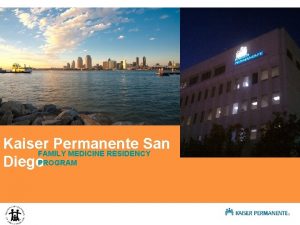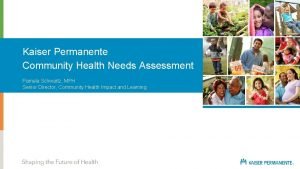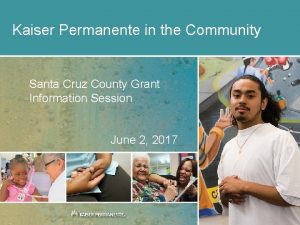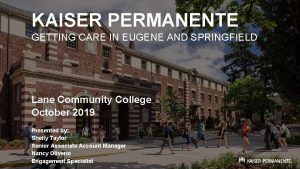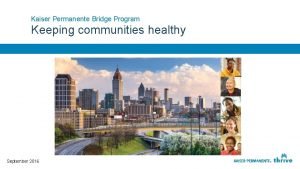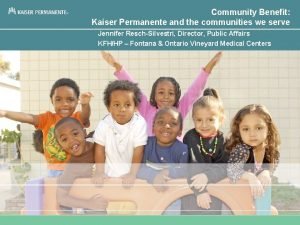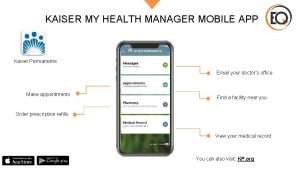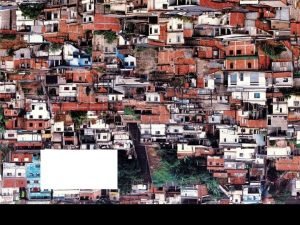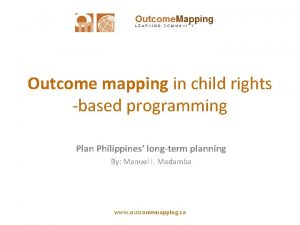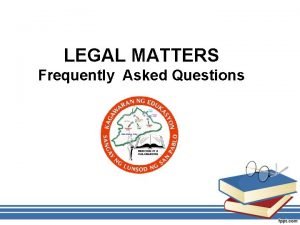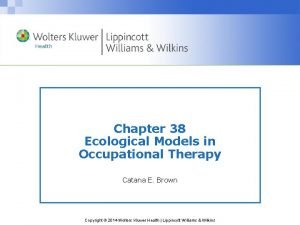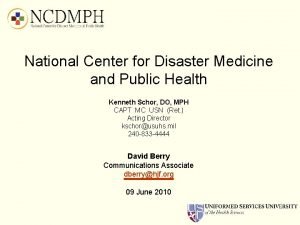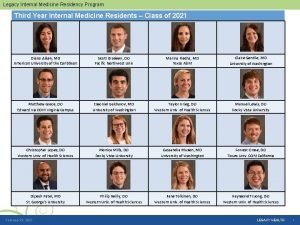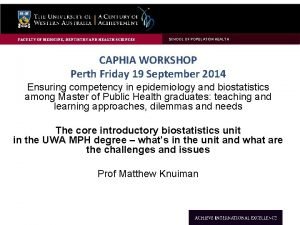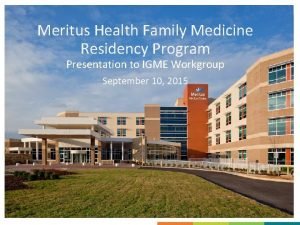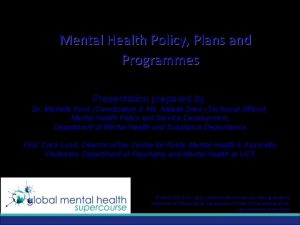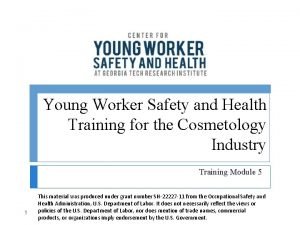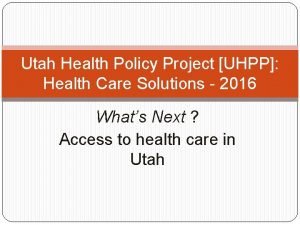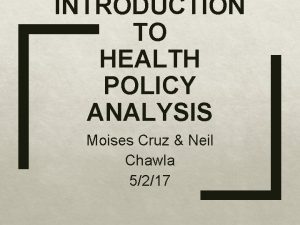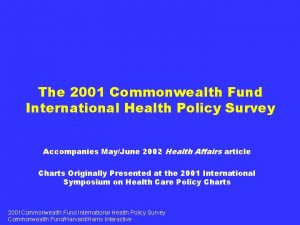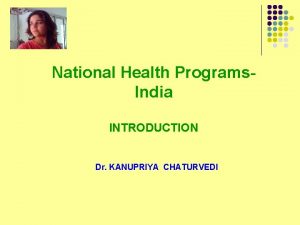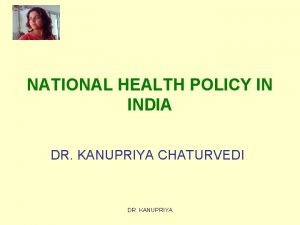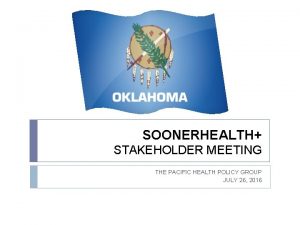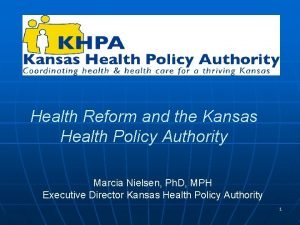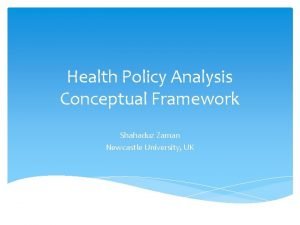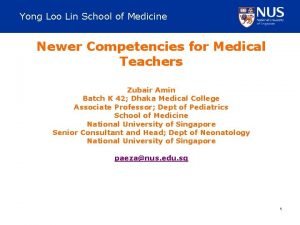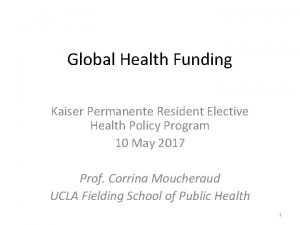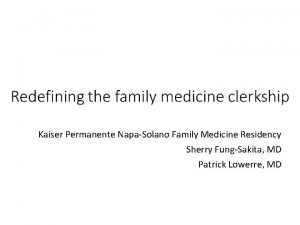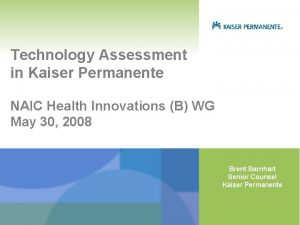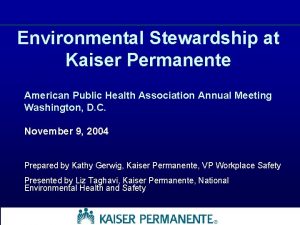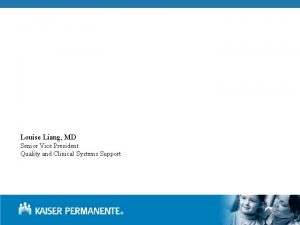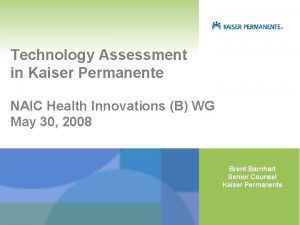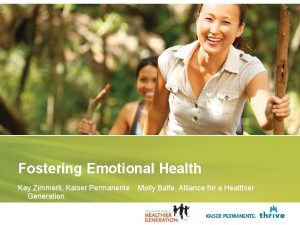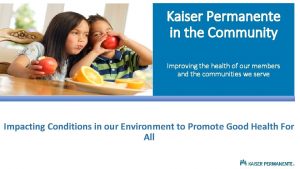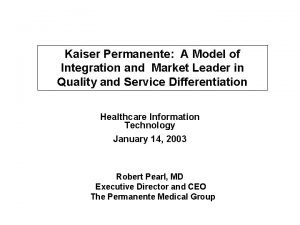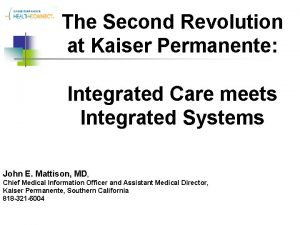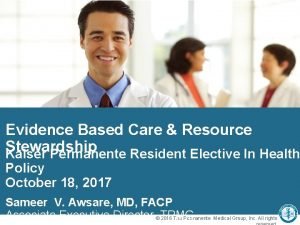KAISER PERMANENTE SCHOOL OF MEDICINE Child Health Policy








































- Slides: 40

KAISER PERMANENTE SCHOOL OF MEDICINE Child Health Policy in the US Paul J. Chung, MD MS; Health Systems Science, Kaiser Permanente School of Medicine 1 kp. org/schoolofmedicine November 22, 2020 CONFIDENTIAL © 2016 Kaiser Foundation Health Plan, Inc.

Child Health Policy in the US KAISER PERMANENTE SCHOOL OF MEDICINE Stuff You Already Know § Health care spending rises almost continuously § In 1960, 5% of GDP; in 2016, 18% of GDP ($10, 348/person) § More than national defense, Social Security, and public education combined § If we… § reduced health care spending by just 1% GDP § and reallocated that money to existing programs § we could cut US child poverty in half…by ourselves § US spends vastly more than other developed countries § Twice as much by %GDP as OECD median § 40% more by %GDP than world #2 (Switzerland) 2 November 22, 2020

Child Health Policy in the US KAISER PERMANENTE SCHOOL OF MEDICINE Stuff You Already Know, Part 2 § Among developed nations, US worse than median on: § Health status—Life expectancy at birth, life expectancy at 65, infant mortality, potential years of life lost, suicide rate § Health resources—Number of hospital beds, number of doctors § Health care—Number of doctor visits, child vaccination rates, length of hospital days, number of hospital discharges § US wastes up to 1/3 of all health care spending on unnecessary or improper care § Central problem of US health care: § Extraordinary prices for very ordinary service § Health care is not just enormous cost but enormous opportunity cost 3 November 22, 2020

Child Health Policy in the US KAISER PERMANENTE SCHOOL OF MEDICINE What We Need to Do § Reduce health care spending and investments by 1/3 § 6% GDP = $1. 1 trillion/year § Reallocate 6% GDP to health-promoting non-health care spending and investments § Redesign both health care and health-promoting non-health care systems to increase efficiency, effectiveness, and equity § How to reduce, reallocate, and redesign 1/6 of US economy is the fundamental health policy challenge and opportunity of our lifetimes 4 November 22, 2020

Child Health Policy in the US KAISER PERMANENTE SCHOOL OF MEDICINE A Question of Value § Value = ∆ Health (or Outcomes or Quality) / ∆ Costs § Origins in quality, cost effectiveness, and outcomes movements § Value depends on how health and costs are defined and prioritized § Health and Costs § What measures should be included? § Whose health and costs should be counted (individual, family, provider, payer, government, society)? § Who gets to decide? § Health, cost, and value are political, not scientific, constructs 5 November 22, 2020

Child Health Policy in the US KAISER PERMANENTE SCHOOL OF MEDICINE What Is Health? § No one knows § WHO definition (1948) § “a state of complete physical, mental and social well-being and not merely the absence of disease or infirmity” § Somewhat useful—established physical, mental, and social domains; importance of well-being; but ultimately meaningless § Ottawa Charter for Health Promotion (1986) § “a resource for everyday life, not the objective of living. Health is a positive concept emphasizing social and personal resources, as well as physical capacities. ” § More useful—health is not an end, but a means to an end; but what end? 6 November 22, 2020

Child Health Policy in the US KAISER PERMANENTE SCHOOL OF MEDICINE Getting Closer… § Netherlands Organization for Research & Development (2009) § “an inner resource, a capacity, an ability, a potentiality to cope with or adapt to internal and external challenges, to perform (relative to potential, aspirations and values), to achieve individual fulfillment, to live, function, and participate in a social environment, to reach a high level of well-being, even without nutritional abundance or physical comfort” § Perhaps achieving optimal health means: § Maximizing one’s individual potential, and then § Participating in society to best of one’s ability 7 November 22, 2020

Child Health Policy in the US 8 November 22, 2020 KAISER PERMANENTE SCHOOL OF MEDICINE 8

Child Health Policy in the US KAISER PERMANENTE SCHOOL OF MEDICINE A Better Definition of Health § Perhaps health can be defined as: § Expected future net societal productivity § “Expected future” § Present health = future potential through remainder of life course § “Net” § What you give is diminished by what you take § “Societal productivity” § Measured as probabilistic benefit to society (i. e. , others) § Not only economic but also non-economic (e. g. , care, joy) § We find our gift, and then give it away 9 November 22, 2020

Productivity Across the Life Course § Net food production and survival of human foragers and chimpanzee s (Kaplan et al. , 2009) § Light lines = chimpanzees § Dark lines = human foragers 10 November 22, 2020

Child Health Policy in the US KAISER PERMANENTE SCHOOL OF MEDICINE What Childhood Factors → Adult Productivity? § Physical and mental health status, behaviors, and care …but also… § Fetal development vs. stress § E. g. , fetal origins of adult disease (Barker hypothesis) § Resilience vs. traumatic/environmental exposures § E. g. , adverse childhood experiences (ACEs), injuries, toxins § Social integration vs. isolation § E. g. , child protection, incarceration, racism § Child development and education § Economic security and equality 11 November 22, 2020

1 2 Fetal Origins of Adult Disease § Not only infant mortality but also adult cardiovascul ar outcomes are strongly associated with birth weight (Dover et al. , 2009) 12 November 22, 2020

Child Health Policy in the US KAISER PERMANENTE SCHOOL OF MEDICINE Adverse Childhood Experiences § Childhood exposure to abuse, neglect, household dysfunction § 4+ (vs. 0) ACEs associated with (Felitti et al. 1998): § § § § 13 Alcoholism (OR 7. 4 [5. 4 -10. 2]) Illicit drug use (OR 4. 7 [3. 7 -6. 0]) Chronic lung disease (OR 3. 9 [2. 6 -5. 8]) Sexually transmitted infection (OR 2. 5 [1. 9 -3. 2]) Stroke (OR 2. 4 [1. 3 -4. 3]) Ischemic heart disease (OR 2. 2 [1. 3 -3. 7]) Cancer (OR 1. 9 [OR 1. 3 -2. 7]) Diabetes (OR 1. 6 [OR 1. 0 -2. 5]) November 22, 2020

Child Health Policy in the US KAISER PERMANENTE SCHOOL OF MEDICINE Youth Incarceration § Youth incarceration >1 year associated with (Barnert et al. , 2017): § Adult functional limitations (OR 2. 9 [1. 5 -5. 6]) § Adult depressive symptoms (OR 4. 2 [2. 5 -7. 1]) § Adult suicidal thoughts (OR 2. 3 [1. 1 -5. 0]) § Adult outcomes even worse when incarceration occurred at <15 years old (Barnert et al. , 2018) 14 November 22, 2020

1 5 Education and Health in US § Remaining life expectancy at age 25 (Rostron et al. , 2010) § College graduate: 62 years (women), 57 years (men) § High school graduate: 56 years (women), 51 years (men) § Less than high school graduate: 50 years (women), 44 years (men) 15 November 22, 2020

1 6 Income and Health in US § Expected age at death for 40 -year -olds (Chetty et al. , 2016) § Top 1% household income: 89 years (women), 87 years (men) § Bottom 1% household income: 79 years (women), 73 years (men) 16 November 22, 2020

1 7 Education and Income in US 17 November 22, 2020

1 8 The Result: Segregation of Health § Family, social, educational, and economic systems define and are defined by neighborhoods § Neighborhoods becoming more homogeneous and extreme over time (Reardon et al. , 2011) 18 November 22, 2020

1 9 Breaking the Cycle: Moving to Opportunity § HUD-sponsored RCT in 1990 s (Chetty et al. , 2016) § Gave low-income families vouchers to move to lowpoverty neighborhoods § Income by ages 20 -28 § Blue = moved before age 13 § Red = moved age 13 -18 § But you can’t move everyone § Also need solutions independent of mobility 19 November 22, 2020

Child Health Policy in the US KAISER PERMANENTE SCHOOL OF MEDICINE Education: Early Childhood Development § Perry Preschool § Preschool plus home visitation program with certified teachers in lowincome black community in Michigan § Compared participants vs. non-participants through age 40 § No long-term differences in IQ scores (non-cognitive!), but less special education, higher achievement scores, higher high school graduation rates, higher incomes, less arrests § 16% annual ROI to participants, 12% annual ROI to society § $17 returned to society for every $1 invested by age 40 § Results partially replicated in studies in New York, North Carolina, and Head Start § Side note—Universal preschools? 20 November 22, 2020

Child Health Policy in the US KAISER PERMANENTE SCHOOL OF MEDICINE Education: The Importance of Teachers § Teacher value-added § Measured by student test score changes statistically attributable to teacher exposure; limited and controversial measure § Chetty et al. (2014) examined 20 years of school district and tax data for 2. 5 million 3 rd-8 th graders and their Math and English teachers § Exposure to just 1 higher-value teacher in 1 year had no long-term impact on test scores (non-cognitive!), but increased adult earnings and wealth, increased college attendance and college quality, and reduced teen pregnancy § Replacing just 1 low-value teacher with 1 average-value teacher returned $200, 000 in increased adult earnings per classroom per year 21 November 22, 2020

2 2 Is There a Child Health Story to Be Told? 22 November 22, 2020

2 3 Example #1: Many Health Behaviors Are Improving 23 November 22, 2020

2 4 …And Health Insurance Coverage Is Rising 24 November 22, 2020

2 5 …But So Are Chronic Healthcare Needs 25 November 22, 2020

2 6 …And Recently, Mental Health Problems 26 November 22, 2020

2 7 Example # 2: Prenatal Care and Maternal Smoking Are Improving 27 November 22, 2020

2 8 …And Teen Births and Infant Mortality Are Dropping 28 November 22, 2020

2 9 …But Low Birthweight Isn’t Changing 29 November 22, 2020

3 0 …And Maternal Mortality Is Rising 30 November 22, 2020

Child Health Policy in the US KAISER PERMANENTE SCHOOL OF MEDICINE What Is Going On? § There are limits to what individual/public health/health care system improvements can accomplish § Binge drinking, health insurance coverage, prenatal care, maternal smoking, teen births, and infant mortality are all improving § But to what end? § Social/environmental systems are the sine qua non of health § How do we leverage and/or redesign social systems to improve health? 31 November 22, 2020

Some Social Systems Are Improving 32 November 22, 2020 32

3 3 We Are Becoming a Less Violent Society 33 November 22, 2020

3 4 …And a Less Vindictive One 34 November 22, 2020

3 5 We Are Making Gradual Gains in Education 35 November 22, 2020

3 6 …And Gradually Reducing Poverty Figure 1 a: Official Poverty Rates Vs. Anchored SPM Poverty Rates for Children Aged 0 -5, 1968 -2011 SPM OPM 40. 0% 35. 0% 30. 0% 25. 0% 20. 0% 15. 0% 10. 0% 5. 0% 19 6 19 8 7 19 1 7 19 4 7 19 7 8 19 0 8 19 3 8 19 6 8 19 9 9 19 2 9 19 5 9 20 8 0 20 1 0 20 4 0 20 7 10 0. 0% 36 November 22, 2020 § In 2017, child poverty in US 15. 6% (SPM) instead of 17. 5% (official) after accounting for such things as: § Refundable tax credits (e. g. , EITC, CTC) -6. 1% § SNAP (food stamps) -2. 0% § Social Security -2. 0% § Housing subsidies -1. 2% § School lunch -1. 0% … § FICA taxes +1. 9% § Work expenses (e. g. , child care) +2. 4% § Medical OOP expenses +3. 1%

3 7 But Inequality and Segregation Haunt Us § Expected age at death for 40 -year-olds (Chetty et al. , 2016) § Large gradient by household income in every city § Cities begin to diverge below median household income § At bottom 5%, gap between New York and Detroit is 6 years 37 November 22, 2020

3 8 …And It’s Even Worse Than You Think § Life expectancy at birth in LA County (LAC DPH, 2010) § Difference between highest and lowest neighborhoods is 16 years § Strongly correlated with neighborhood-level gaps across all key determinants 38 November 22, 2020

3 9 Plus There’s This. Holy Hell. 39 November 22, 2020

Child Health Policy in the US KAISER PERMANENTE SCHOOL OF MEDICINE What Should Child Health Policies Look Like? § Individual, family, and health care system policies are important § But they are incomplete and relatively ineffective without broader social/environmental system policies (e. g. , schools, neighborhoods, local institutions and infrastructures) § Policies should be focused on key childhood determinants of adult health § Policies should deliberately address segregation and disparities by place, race, gender, and other factors 40 November 22, 2020
 Kaiser san diego family medicine residency
Kaiser san diego family medicine residency Pamela schwartz kaiser
Pamela schwartz kaiser Code purple kaiser
Code purple kaiser Kaiser permanente letterhead
Kaiser permanente letterhead Kaiser permanente eugene
Kaiser permanente eugene Kaiser bridge program
Kaiser bridge program Kaiser permanente mission vision statement
Kaiser permanente mission vision statement Mfa kaiser northern california
Mfa kaiser northern california Rx bin kaiser
Rx bin kaiser Kaiser permanente value compass
Kaiser permanente value compass Kaisermyhealth
Kaisermyhealth Kaiser permanente spokane walk in clinic
Kaiser permanente spokane walk in clinic National policies related to child health and welfare
National policies related to child health and welfare Master of health administration monash
Master of health administration monash National programmes related to nutrition
National programmes related to nutrition Medicine bundle for the non-born child
Medicine bundle for the non-born child Opinyon tungkol sa child protection policy
Opinyon tungkol sa child protection policy One child policy
One child policy Child protection policy example
Child protection policy example 2 disinterested person
2 disinterested person Left child right child tree representation
Left child right child tree representation Faculty of medicine nursing and health sciences
Faculty of medicine nursing and health sciences Ehp occupational therapy
Ehp occupational therapy National center for disaster medicine and public health
National center for disaster medicine and public health Legacy internal medicine residency
Legacy internal medicine residency Duke family medicine and community health
Duke family medicine and community health Pubh4401
Pubh4401 Meritus primary care
Meritus primary care Existanxe
Existanxe Mental health policy, plans and programmes michelle funk
Mental health policy, plans and programmes michelle funk Safety and health policy example
Safety and health policy example Po box 24080 newark nj 07101
Po box 24080 newark nj 07101 Utah health policy project
Utah health policy project Policy analysis landscape example
Policy analysis landscape example Commonwealth fund international health policy survey
Commonwealth fund international health policy survey Dr. kanupriya chaturvedi
Dr. kanupriya chaturvedi Dr. kanupriya chaturvedi
Dr. kanupriya chaturvedi Pacific health policy group
Pacific health policy group Kansas health policy authority
Kansas health policy authority Policy triangle framework
Policy triangle framework Yong loo lin school of medicine
Yong loo lin school of medicine
